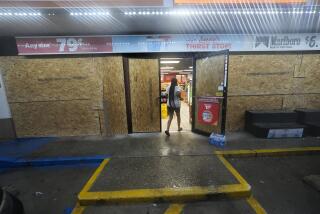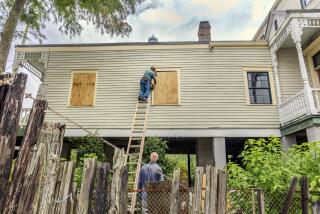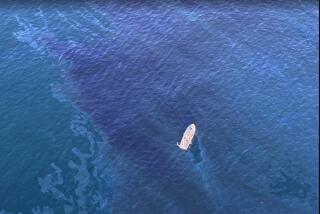Frantic drive to spare Gulf Coast from oil spill
Reporting from Louisiana and Los Angleles — A flotilla of vessels attacked a massive oil spill in the Gulf of Mexico on Thursday with skimmers, booms and chemicals, hoping to lessen the ecological impact when the slick makes landfall in Louisiana.
Louisiana Gov. Bobby Jindal declared a state of emergency after it became apparent that the scope of the disaster was far greater than it had appeared earlier, threatening the natural resources and economy of his state. President Obama pledged to deploy “every single available resource at our disposal, including potentially the Department of Defense.”
FOR THE RECORD:
Oil spill: An article in Friday’s Section A about efforts to fight the oil spill in the Gulf of Mexico misspelled the last name of U.S. Coast Guard Petty Officer Matthew Schofield as Scofield. —
“This is a spill of national significance,” Homeland Security Secretary Janet Napolitano told reporters at a White House briefing. The designation means that assets from across the country can be used to fight the spill, which threatens a fragile Mississippi Delta ecosystem already damaged by Hurricane Katrina.
The crisis began last week when the oil rig Deepwater Horizon sank in deep gulf waters, days after it exploded and caught fire. Of its crew of 126, 11 are missing and presumed dead. The rig was owned by Transocean Ltd. and operated by BP, which is responsible for the cleanup.
Oil has been leaking at a rate of 5,000 barrels a day. Because it could take 90 days to drill a relief well to stem the flow, the spill could reach 18.9 million gallons, more than leaked from Exxon Valdez in Alaska’s Prince William Sound, the worst spill in U.S. history.
The gulf spill began to reach the Mississippi Delta by sunset Thursday, the Associated Press reported, and booms intended to protect the shore were being over topped by 5-foot waves.
Louisiana’s wetlands and some of the nation’s richest fishing grounds are threatened.
“Everybody is really worried about potential ecological disasters,” Nancy Rabalais, executive director of the Louisiana Universities Marine Consortium, said from her office in Cocodrie, La., on Terrebonne Bay. “The oil is going to move somewhere. It’s not as likely to move offshore.”
The Coast Guard was coordinating vessels including 76 boats and 17 aircraft. The boats include skimmers, tug boats and robotic submarines, which are investigating the underwater damage, said Petty Officer Matthew Schofield. About 174,000 feet of booms have been laid and an additional 243,000 feet are available. The Coast Guard has deployed 1,178 crewmembers. California experts are also en route.
“Our end goal remains permanently securing the well,” said U.S. Coast Guard Rear Adm. Mary Landry, the federal on-scene coordinator.
Landry said emergency crews were hoping to begin using chemicals to disperse the oil underwater — something that has never been done at such depth, about 5,000 feet. Landry called the technique “novel” and said crews were waiting for final approval to use it.
Officials said they were prepared to sink a relief well and to consider a second relief well to stem intense pressure that was sending oil spewing from underwater pipes.
“Nobody, absolutely nobody, wants to get this oil flow stopped more than I do,” said Doug Suttles, chief operating officer for BP Exploration and Production. He said he had contacted other industry experts for their ideas to contain the spill.
The Department of Defense was evaluating whether it could contribute to the effort, spokesman Geoff Morrell said. The Coast Guard is part of the Department of Homeland Security.
Coast Guard officials said stormy conditions expected late Thursday could cause crews to suspend operations. The National Weather Service forecast rain and thunderstorms, with rough seas expected.
The oil spill could not have come at a worse time for the Gulf Coast’s sea life, wildlife and bird species. Late spring is the peak time for neo-tropical songbirds moving from the Yucatan Peninsula to make landfall in Louisiana. As many as 25million birds a day arrive during this northern migration. More than 70% of the country’s waterfowl frequent the gulf’s waters, including the brown pelican, which is in its nesting season.
Federally protected marine mammals — whales, dolphins and sea turtles — are among the species at risk. Biologists fear turtles that swim to shore to lay eggs in the approaching nesting season could become coated with oil.
The 400 miles of shoreline near the spill area include a national park and more than 20 national wildlife refuges.
“It’s a very complicated system that is sensitive to change in any piece of it,” said Karen Westphal, a coastal wetlands expert with the Louisiana Audubon Society. “Our marshes are not a wall. This spill is not going to stay on that outer edge. It’s a sieve.”
The $1.6-billion-a-year fishing industry along the Louisiana coast is in the midst of shrimp season, and oyster spawning and harvesting. In some areas, biologists say, plankton may be affected. That could mean that fish larvae will either not find food or the food could be contaminated, entering the food chain.
The front line in the fight against the spill could be found about an hour’s boat ride offshore from the fishing town of Venice, La., where the fingerling tributaries of the Mississippi River dump into the gulf.
In the South Pass waterway, about a mile from the turbulent waters of the gulf, a pair of 30-foot work boats sidled up behind larger crew boats. Workers in hard hats passed long lengths of boom to the smaller boats, which would ferry them out to the gulf. The lengths of boom resembled long strips of cheap lifejackets, filled with buoyant foam and covered in safety-orange waterproof material. Boom lines were visible around the mouth of the pass.
In Venice, which bills itself as the fishing capital of the world, crew boats that normally service the offshore rigs and platforms were busy ferrying supplies and people to the response ships offshore. At the Venice Marina, sport fishermen were pulling their boats from their slips and hauling them onto dry land, fearing the effects of the oil on their hulls.
“They’re scared, really,” said Greg “Bubba” Ancalade, 19, a marina worker.
Still, sport fishing boats were heading out in the morning, filled with fishermen hoping to get in a few quality hours before things went bad.
“I’m not concerned about our trip, but I’m concerned for the environment,” said Clay Bratton, 41, of Biloxi, Miss., as he prepared his 24-foot bay boat for a day pursuing redfish. “This environment’s taken a beating, and it can’t take much more oil on top of it.”
The enormous slick could compound Louisiana’s perennial problem with a low-oxygen “dead zone,” which spreads across the seafloor in an area the size of New Jersey, killing fish and shellfish that cannot swim or scuttle away.
Monitoring stations run by the Louisiana Universities Marine Consortium have already detected some low-oxygen zones, Rabalais said. The year’s zone could be exacerbated, she said, by oil on the surface blocking any life-giving oxygen from enriching the water.
The spill was also threatening the financial health of BP, even as the company earned praise for its aggressive response to the crisis.
“So far, they are responding well,” said Phil Weiss, a senior energy analyst for Argus Research. “Their reaction has been the right one. They are throwing a lot of resources at this to try to stop it.”
BP shares were taking a battering. Stock prices were also dropping for Houston-based Cameron International, which provided the rig’s blowout protector; for Halliburton Co., which cemented the well; and for
offshore oil driller Transocean.
But, Weiss added, “the environmental issues fall first to the operator. And that is BP.”
mitchell.landsberg@latimes.com
More to Read
Sign up for Essential California
The most important California stories and recommendations in your inbox every morning.
You may occasionally receive promotional content from the Los Angeles Times.









